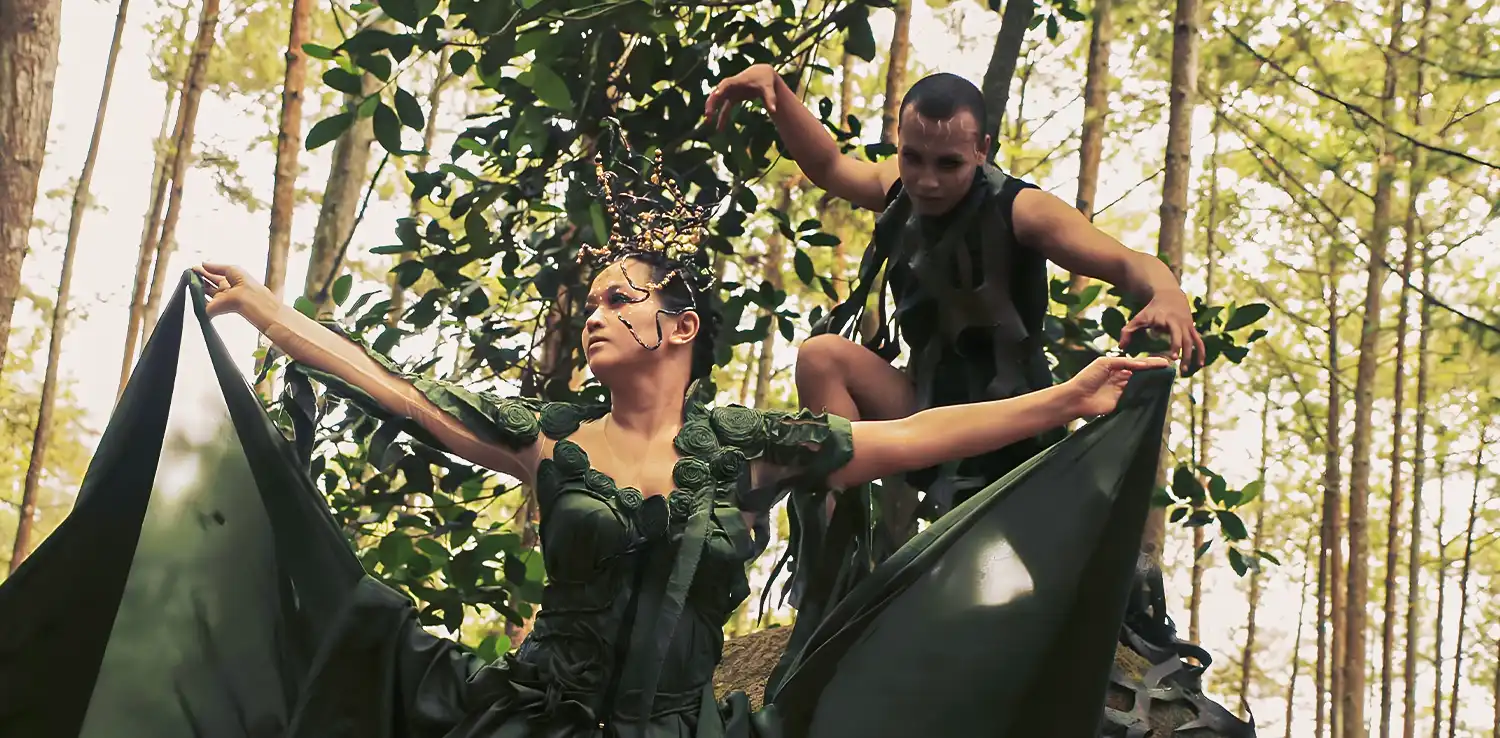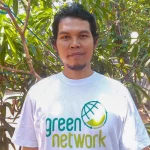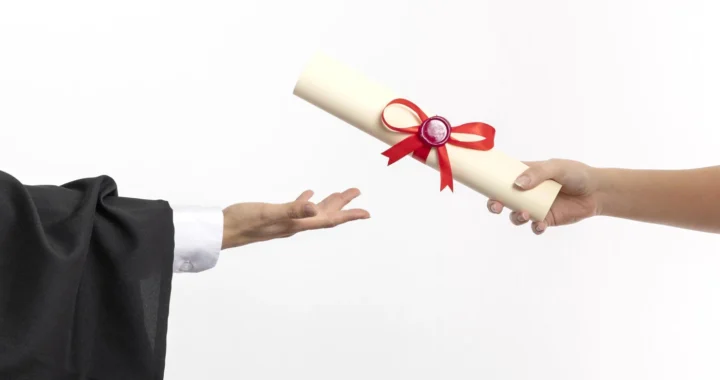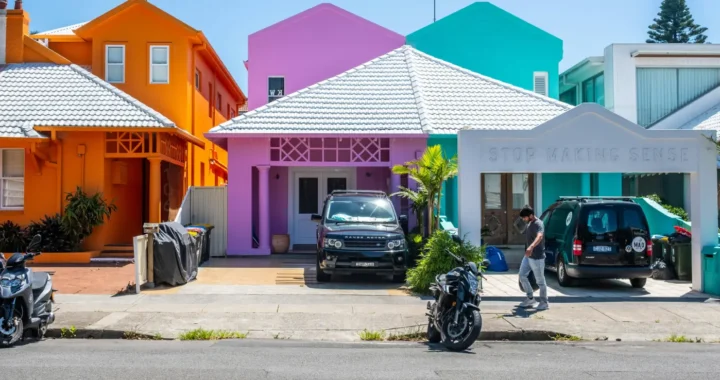Lena Guslina Raises Awareness on Environmental Destruction Through Dance

Lena Guslina. | Photo: Legus Studio Collection.
The earth is wounded. Massive environmental exploitation—such as deforestation, extractive industry expansion, and land use change—has led to natural disasters everywhere, including in Bandung, West Java, Indonesia. From floods to landslides to forest fires, disasters can happen anytime, now more frequently than before, and with varying impacts on various people. For the Bandung-based choreographer and contemporary dancer Lena Guslina, the impact runs deep.
Lena is a Bandung native, born in the city on August 16, 1977. These days, she is almost afraid to leave the house when the clouds get dark. She knows very well that every time it rains, her city will be flooded, and traffic jams will ensue. She sees that floods have happened more frequently in Bandung in recent years, particularly since housing complexes are emerging just below the mountains. In 2010, green sceneries still welcomed her whenever she gazed upon the mountains. Now, the greenery has changed into houses.
“When the rain falls, all of the water is streaming downtown. Schools are drowned. It’s all over the place. Floods are happening everywhere, even flash floods. Landslides also happen in several regencies, including in Garut,” said Lena. “We’re not just talking about Bandung. I believe environmental issues have no geographical limit–it’s global. These issues are stuck inside my head, evolving into inner turmoils that push me to do something. I can’t just stay still.”
Responding to Environmental Destruction with Dance

Environmental destruction disturbs Lena Guslina. As an artist who has spent 22 years of her life pursuing dance, Lena responds to turmoil through the sway of her body. She pours it all into contemporary dance performances and performs them publicly to raise people’s awareness.
“Through dancing, I want to remind people about the environmental wreckage. I am not thinking too far about the possible impacts—this is just my intuitive response. But, I feel like I have to protest against environmental destruction through art, hoping to provide an alternative way to make people realize it. This is only my small contribution, which may seem insignificant to some people,” said Lena, who graduated from the Indonesian Arts and Culture Institute, Bandung.
In 2016, Lena held various choreography and dance performances in Bandung’s public parks to protest against the way the city government handled environmental issues, which, according to her, didn’t touch the fundamental problem.
“I think Bandung’s public parks were already pretty enough. It wasn’t the problem. The government shouldn’t only revitalize public parks, widen tunnels, and do all other things in the name of beauty. There were far more serious problems that we needed to collectively think about. Forests and mountains needed savings. How was it possible to turn forest areas into housing complexes? It wouldn’t have been possible without the government’s permission,” she said.
To make her protest echo louder, Lena moved her performance to the forests in West Java starting in 2017. In every performance, she involved many people, including musicians, pantomimists, and actors, to put out shows with different concepts to stay fresh. Several of Lena’s choreographies that express her concern for the environment include Jejak Rimba (The Forest’s Print), Air Mata Bumi (Earth’s Tears), Dialektika Tubuh Taman dan Hutan Kota (Dialectics of the Body of City Parks and Forests), Desah Rimba (The Forest’s Sigh), and Elegi Bumi (Earth’s Elegy). Lena has performed these choreographies on multiple occasions in front of large audiences.
Lena also has performed choreographies and dances to convey her concern for the victims of natural disasters several times. One of them is Gemuruh Sunyi (The Roar of Silence), which she performed at a charity donation event for the victims of the Palu-Donggala earthquake in Babakan Siliwangi City Forest, Bandung, in November 2018.
“I held theatrical dance performances in the forests. The first was in the Manglayang Forest, then Dago Forest, then Babakan Siliwangi City Forest, and others. I also went to Bali to perform at a mangrove forest. Previously, I only talked about biodiversity issues, but lately, I also bring up the issue of plastic waste, which is now the monster [to the environment],” said the founder of Legus Studio.
Lena Guslina’s Struggles and Challenges

Lena shared that holding performances in forests isn’t as easy as it seems. There is a long process behind them, from preparing costumes and properties to obtaining permission from related institutions. It often takes weeks.
“It’s funny because I still need to get permission whenever I perform, even though my shows are for the public’s good and have nothing to do with commercial gains,” said Lena.
Lena believes that artists have to be willing to struggle and contribute to solving the world’s pressing problems. She has never received financial support for every performance. It all comes out of her pocket.
“From costume procurements to food to surveys, I do them all without the government or other institutions’ help. Artists must be willing to make sacrifices, whether physically or materially. I believe that it will all return to me someday, the good intentions. What has been constant is the support I receive from my friends. It has become the most important thing,” she said.
Lena’s sacrifices are paid off through the audience’s enthusiasm. Her shows have received multiple media coverages for bringing up environmental issues. Through dancing, Lena hopes to drive changes in society.
“Without me doing this, the government should still be concerned about environmental issues. If everyone turns a blind eye, what will we become?” said Lena.
Careful Time Management

Driving changes through her contribution to art is a challenge for Lena. It’s not uncommon for her to face dangerous situations when performing in open spaces. Once, when she was about to perform for an event at the National Gallery of Indonesia, Lena had to withstand strong winds for two hours on stage and keep her costume intact.
Another time, her properties went missing on the day when she had to perform in a forest. The mother of two also has to allocate her time for her family and other matters beyond her desire to advocate for environmental issues.
“I have to be careful in managing my time. I have to take care of my husband and kids as well. When my kids are sick, for example, then I have to tend to them,” said Lena.
Lena always strives to ensure that every single one of her performances can be welcomed by everyone. “When we have tough determination in doing things, no matter the shape or situation, people won’t bat an eye whether you’re a woman or man. I think people will no longer see genders, but the concept. It’s about how we can offer fresh concepts to express things through art,” she explains.
Dancing on Canvas

When the COVID-19 pandemic struck, Lena’s body felt caged. She couldn’t perform outside due to mobility restrictions. The channel to express her art was blocked. At that time, Lena felt pressured psychologically, mainly because of the negative news on COVID-19 from various media.
Still, Lena’s creativity couldn’t be contained just yet. When she couldn’t perform outside, Lena’s fingers quietly danced on canvases. Through paintings, she channeled all the anxious energy she felt while staying home due to the pandemic, which cannot be separated from environmental destruction. When mobility restrictions started to ease out, her 30 pieces of painting were exhibited at the Bandung Cultural Center Gallery on March 20–23, 2022, titled “Kumau Diriku: Gerak Garis Lena Guslina.” All of the paintings were created without brushes, just through the moves of her fingers.
Many people were surprised then, mainly because Lena was famous as a dancer and choreographer.
“There were several forest areas where entering was forbidden because of the pandemic and strict rules. Then, social distancing happened. We couldn’t go out. Eventually, I conveyed my restlessness on canvas. I illustrated the earth’s condition through painting,” said Lena.
Like her choreography, Lena hopes her paintings can spark people’s awareness of environmental destruction and ignite actions to mitigate it. She believes art is the best channel to drive change because the message is conveyed beautifully.
“Artists have a tremendous role [to drive change], moreover when the calling comes from within. So, artists need to be supported,” she concludes.
Translator: Kresentia Madina & Nazalea Kusuma
Read the Indonesian version of this article at Green Network Asia – Indonesia.
Thank you for reading!
Green Network Asia – International Annual Individual Membership supports your personal and professional growth with unlimited online access to our “Exclusive Content” platform purposefully designed to showcase cross-sectoral insights on sustainable development and sustainability in the Asia Pacific and beyond. Enjoy the Membership benefits, including -but not limited to- public policy & regulatory updates, easy summaries of research findings & reports, and impact stories from governments, businesses, and civil society.

Abul Muamar
Amar is the Manager for Editorial-Indonesia at Green Network Asia. He graduated from Universitas Gadjah Mada with a master's degree in Philosophy and Universitas Sumatera Utara with a bachelor's degree in Communication Science. He has ten years of professional experience in journalism.


 Upholding the Machángara River’s Rights of Nature Against Pollution
Upholding the Machángara River’s Rights of Nature Against Pollution  Accelerating Gender-Responsive Disaster Management with Sendai Gender Action Plan
Accelerating Gender-Responsive Disaster Management with Sendai Gender Action Plan  ASEAN and the EU Support Sustainable Connectivity with a Higher Education Program
ASEAN and the EU Support Sustainable Connectivity with a Higher Education Program  Australia Proposes Right to Housing Bill to Tackle Housing Crisis
Australia Proposes Right to Housing Bill to Tackle Housing Crisis  World Cities Summit 2024: A Trigger to Help Build a Sustainable Singapore
World Cities Summit 2024: A Trigger to Help Build a Sustainable Singapore  Mama Bambu: How Women in Flores, Indonesia Take Part in Environmental Conservation
Mama Bambu: How Women in Flores, Indonesia Take Part in Environmental Conservation